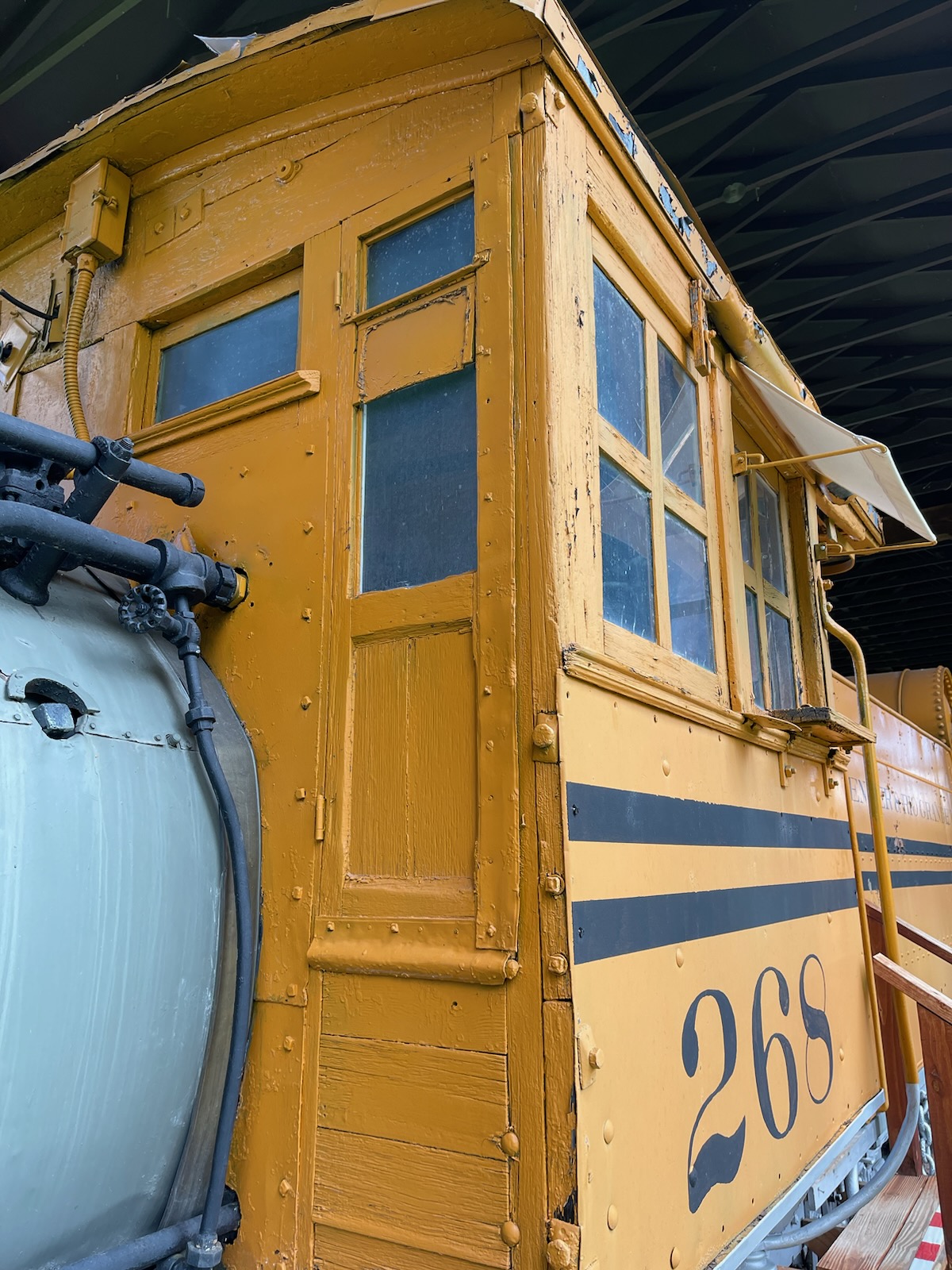Locomotive 268
Excepts From
Gunnison County Pioneer and Historical Society's
"The Gunnison Train"
Written by: Jerry Day
She was the last of her type to see active service. In her one hundred and ten years of existence, she starred in a Hollywood movie (she had a stand-in), was the center of attention at the Chicago Railroad Fair, gave Santa Claus a ride, and was displayed in Denver alongside a nuclear missile. She is Denver and Rio Grande Western railroad locomotive number 268. With repairs she could still pull a train through the Black Canon, over Marshall Pass, or to Crested Butte. She is the star of the Gunnison Pioneer Museum.

Locomotive 268 doubleheading with number 458 on the Marshall Pass passenger train about 1912. (William Endner photograph)
Locomotive 268 was built by Baldwin Locomotive Company in Philadelphia, Pennsylvania in March 1882 (Baldwin Locomotive construction number 6002). 268 was one of 150 similar locomotives built by the Baldwin Locomotive Company and the Grant Locomotive Company. 268 was one of a group of 45, numbers 250 to 295, built by Baldwin in 1881 and 1882. The Denver and Rio Grande railway classified engine 268 as a Class 60N Consolidation tvpe. It weighed 59,330 pounds and had a 2-8-0 wheel arrangement (two leading wheels and eight driving wheels). In 1923, the D&RGW changed their locomotive classifications from one based on weight to one based on tractive effort (pulling power). 268 was reclassified as a Class C-16 (meaning it had a pulling power of 16,540 pounds). 268 could pull 290 tons from Gunnison to Crested Butte and 210 tons from Gunnison to Castleton (it could pull more to Crested Butte because the grade was less).
After being transported to the Denver & Rio Grande Railway Burnham shops in Denver by standard gauge flat car, 268 was unloaded and placed in service on the rapidly expanding Rio Grande narrow gauge lines in the part of Colorado. It was probably first used in freight service over Marshall Pass and through the Black Canon; no record of 268's first ten years of service has been found. The first mention of 268 appeared in the Salida Mail newspaper on August 12, 1891:
Wednesday evening about 6:00 0'clock as an extra east was coming up the hill with 268, engineer Hyatt on the head end, a section gang on a push car, coming down the hill between Chester and Tank Seven between Marshall Pass and Sargents collided with the train, injuring two or three men, one it is believed fatally. They are now lying at the Salida hospital.
On November 8, 1912, the Gunnison News Champion reported that Ed Dundin was fireman on locomotive 268 being used at Gunnison. A month later, December 13, 1912, the News Champion reported that it was equipped with a wedge plow and was bucking snow on the branch line between Crested Butte and the Colorado Fuel & Iron Company's coal mine at Floresta.
The Rio Grande Southern was a narrow gauge railroad that ran from Ridgway to Durango, Colorado. Rio Grande Southern often purchased or leased locomotives from the Denver & Rio Grande Western railroad and was for a time operated as a part of the D&RGW. In March of 1925, Rio Grande Southern records show eight locomotives leased from the D&RGW, including: 202, 224, 241, 268, 269, 274, 276 and 305. All were the same type as 268 except 305 which was larger.
Later in 1925, the RGS leased larger 2-8-2 locomotives from the D&RGW and the 268 was returned to the Rio Grande along with the other smaller engines. On October 27, 1927, the 268 was being used with a steam powered ditcher on the Ouray branch. A crewmen was injured when his hand was caught in the dumping mechanism of a dump car. 268 always seemed to be where the action was.
Many changes were made to 268 over the years. In 1903, automatic couplers were added replacing the dangerous link-and-pin couplers. It also lost the long wooden pilot (non-railroaders call it a cowcatcher) in the conversion to new couplers. Around 1914, the original oil headlight was replaced with an electric light to comply with a new Colorado law. When new, 268 had one air pump on the right side (engineer's side). In the late teens or early twenties, a second air pump was to give the engine greater breaking capability and both pumps were placed on the left side.
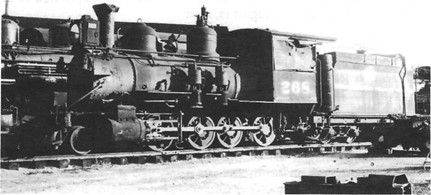
Locomotive 268 in storage at Alamosa, August 1930. Note the boarded—up windows and the box headlight. (Otto Perry photograph from the Denver Public Library, Western History Department)
The 1920s brought prosperity and increased traffic to the Denver and Rio Grande Western. New locomotives and cars were purchased for both the standard gauge and narrow gauge lines. Larger and more powerful narrow gauge locomotives were received in 1923 and 1925 and ten standard gauge locomotives were rebuilt to narrow gauge in 1928 and 1930. Many smaller locomotives were scrapped. Locomotive 268 was placed in storage in Alamosa sometime in the late twenties. 268 remained at Alamosa until 1936 when she was refurbished and sent to Durango to serve as yard switcher. D&RGW records show 268 running alone over Cumbres Pass on October 9, 1936. 268 setved at Durango until 1939 or 1940 when she was sent to Gunnison to work on the Baldwin branch along with locomotives 223 and 278. These three locomotives were the only ones allowed on the Baldwin branch due to a weight restriction on a Gunnison river bridge.
By 1940, locomotives 223, 268, 271, and 278 were the only ones of their type remaining on the D&RGW. Number 223 was placed on display at the Salt Lake City depot in December of 1941. 271 was sold to the Montezuma Lumber Company in December of 1941 and was scrapped in 1947. The 268 and 278 continued in service on the Baldwin branch throughout the 1940s. The little locomotives began to attract the attention of tourists and railfans and in the summer of 1949, 268 was selected to run at the Chicago Railroad Fair. Over $20,000 was used in overhauling 268 and Business Car B3. The locomotive and car were painted in a splendid gold, silver, and black scheme. For the fair, 268 was named "Montezuma" and the B3 was named "General Palmer" (for General William Jackson Palmer, founder of the D&RGW). 268 and B3 ran on a circle of track to the delight of fair visitors. At the close of the fair, 268 was placed in storage at Alamosa; many thought it had run its last miles. However, locomotive 278 was in need of service and in December of 1950, 268 was hauled dead from Alamosa to Salida in preparation for return to service on the Baldwin branch. Before her return to the unglamorous job of hauling coal, 268 served as power for an unorthodox Santa Claus sleigh. On December 22, 1950, 268 and caboose 0578 transported the jolly old man from the Salida rail yards to Main Street for the local children. 268 still in its gold, silver, and black paint from the rail fair and caboose 0578 decorated with deer antlers and a Christmas tree atop the cupola made a festive and colorful appearance. They received almost as much attention as Santa.
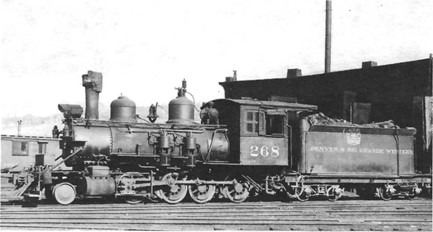
Locomotive 268 at Durango, July 7, 1937. (Photograph by Gerald Best)
All of the media coverage accorded to the little locomotive attracted the attention of motion picture producers looking for scenic locations and authentic equipment for their western epics. In the spring of 1951, 268 was brought to Durango to star in "Denver & Rio Grande," a western drama loosely based on the history of the D&RGW. She retained her gaudy yellow, black, and silver paint in the film. The motion picture crew used the Silverton branch as a stand-in for the Royal Gorge where the original battle between the Rio Grande and Santa Fe railroads occurred. To add drama to the story, two old locomotives, destined for scrap, were loaded with explosives and crashed head-on into each other. One, the 345, was temporarily renumbered to 268 and acted as a stand-in for 268 in the story. The movie company considered purchasing either number 268 or 278 and some cars for movie work; nothing came of the idea. After the filming was complete, 268 was returned to Gunnison, arriving there October 5, 1951.
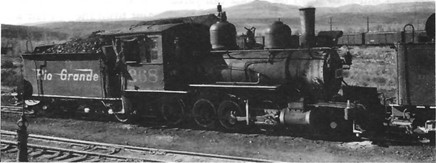
268 in the Gunnison engine terminal, preparing to leave for the Baldwin branch, October 16, 1941. (Otto Perry photograph from the Denver Public Library, Western History Department)
Traffic on the lines out of Gunnison in the early fifties was at an all time low. There wasn't much for the little locomotive to do. 268 and her sister, the 278, were used for occasional runs to Sapinero and a few stock trains on the Baldwin branch. The Baldwin branch coal traffic had ceased with the abandonment of the line from Salida to Alamosa.
The winter of 1952 was a difficult one for little 268. In January, she derailed and almost rolled over at Iola while powering a flanger train to Sapinero. On March 11, pushing a wedge plow, trailing Flanger OJ and two cabooses, 268 spent nine hours bucking snow on a one—way run to Sapinero.
In July of 1952, the Colorado Fuel and Iron Company abandoned their large coal mine at Crested Butte. Shortly after that, the D&RGW applied to abandon all of its narrow gauge lines in the Salida to Gunnison area. In November of 1952, the Rio Grande donated engine 278 to the city of Montrose. This left 268 as the last of her type in service. 268 was given a reprieve in the summer of 1953 as coal slack, left at Crested Butte after the mines closed, was shipped to Salida for transfer to the standard gauge.
After much legal maneuvering and several hearings, approval to abandon the narrow gauges lines was granted in September 1953. After the 268 was used on the last stock shipments out of Gunnison in the fall of 1953, she sat unused in the Gunnison roundhouse until the fall of 1954. On September 28, 1954, 268 made her last run for the Denver and Rio Grande Western Railroad, hauling idle cars from Sapinero to Gunnison (for descriptions of this final run, see "268 Makes Final Run," on page 12 and "The Final Run of Engine 268" on page 13).
On May 3, 1955, Brinkerhoff Brothers (the scrapping contractor) steamed up 268 for use on the scrap trains dismantling the Baldwin, Sapinero, and Crested Butte branches. The Baldwin branch was scrapped first, followed by the Sapinero branch, and finally the Crested Butte branch. 268 made her last run on June 30, 1955, hauling the scrap train from Jack's Cabin to Gunnison. She was replaced by locomotive 489 the next day. On July 16, 1955, 268 was placed on a truck and used as a float in the "Cattlemen's Days" parade. After the parade, she was placed in a park alongside U.S. Highway 50. In the summer of 1959, 268 was moved to the Civic Center Plaza in Denver for the "Rush to the Rockies" centennial celebration. She was displayed along with an intercontinental ballistic missile and a pioneer village replica. She was returned to Gunnison at the end of the celebration.
Of the 150 locomotives of 268's type built in 1881 and 1882, only three remain. Locomotive 223, built by the Grant Locomotive Works in 1881 is displayed at the Salt Lake City depot. Locomotive 278, built by the Baldwin Locomotive Works in 1882, is now displayed by the National Park Service at Cimarron west of Gunnison And, of course, the 268 is proudly displayed at the Gunnison Pioneer Museum.
It has been nearly forty years since little 268 breathed with live steam, forty years since her bell rang and her whistle announced her coming and going to the residents of Gunnison. She has been quiet these many years, but she still lives in still pictures and motion pictures. Who knows the future? Perhaps, someday, she will again awaken and relive those wonderful days when the skies over Gunnison were streaked with her smoke.

268 in front of the Gunnison roundhouse, 1943. The 268 and 278 were the only locomotives permitted on the Baldwin branch at this time. (Lad G. Arend photograph from the Dennis O'Berry collection)
End of Article
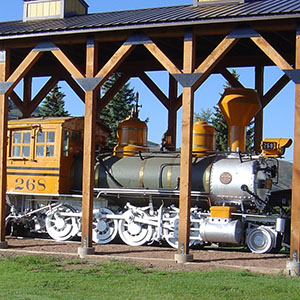
Leighton Moreland, the C16 Society’s Secretary, has been involved with the Gunnison Pioneer Historical Society and D&RGW No. 268 since the summer of 2010 and is the primary conservator of the train display. During these years Leighton has replaced the pilot beam; replaced and restored cab appliances and fittings; installed new correct class lights, and new cab lights among other assorted maintenance tasks. Additionally, he has completed work on the adjoining consist with #268 in Gunnison Pioneer Park. Items such as roof repair and replacement on Caboose 0589, reinstallation of the flanger target on flanger OD, and repair work on the Drop Bottom Gondola.
The locomotive and train display was covered several years ago with a roofed structure for protection from the elements.

Current Projects
The current project for D&RGW 268 is the replacement of the smokestack with one that is correct for her appearance, circa 1952, and removal of the fake cosmetic diamond stack.This project was started prior to the C16 Society’s inception. The stack is funded from a private donation with matching funds coming from the Narrow Gauge Preservation Foundation.
The C16 Society will become active participants in #268’s conservation efforts and will be considering several projects.
The locomotive needs a proper whistle.
The pilot “flanged lift mechanism” was removed at some point and members have plans to replace this flanging apparatus.
The cab will need to be rebuilt.
Once projects are finalized and prioritized a request for donation will be forthcoming.
